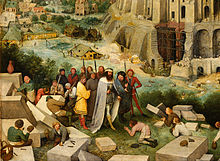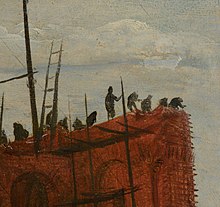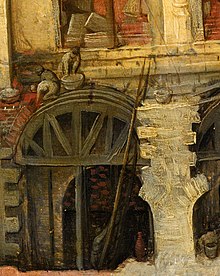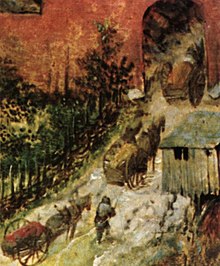Great Tower of Babel

|
| Great Tower of Babel |
|---|
| Pieter Bruegel the Elder , 1563 |
| Oil on oak |
| 114.4 x 155.5 cm |
| Art History Museum |
The Great Tower of Babel is a painting by Pieter Bruegel the Elder from 1563 in the Kunsthistorisches Museum Vienna. The theme is the Tower of Babel described in the First Book of Moses . It is an oil painting on oak wood with the dimensions 114 cm × 155 cm. A second version, dated around 1563, is the Small Tower of Babel in the Boijmans Van Beuningen Museum in Rotterdam.
The paintings
Structure and content
From a medium height, the viewer looks at a stage-like foreground that slopes down into a polder landscape . The defining element of the picture is a gigantic tower construction site, for which a single rock serves as a foundation. On the hill on the lower left a king has arrived with his retinue, in front of whom some workers prostrate themselves. The other people continue their work. An urban landscape spreads out behind the tower construction site with its own port. The building rests on a ring secured with mighty retaining walls, which rises to the ramp and spirals upwards. It has grown so powerful that it shadows part of the city. Numerous tiny figure silhouettes on the construction site also give an impression of the size. The outer walls are made of limestone, while reddish bricks are used for the inner walls. Bruegel shows the construction techniques of his time: stepping cranes are in use, falsework is used for arches and barrel vaults and stonemasons cut sandstone blocks.
interpretation
The theme is the Tower of Babel described in the First Book of Moses:
“And they said, Come on, let us build a city and a tower for ourselves, and its top up to the sky! This is how we want to make a name for ourselves so that we don't scatter over the entire surface of the earth! And the Lord came down to see the city and the tower which the children of men were building. And the LORD said, Behold, they are one people, and they all have one language, and this is only the beginning of what they do. Now nothing will be impossible for them what they think of doing. Up, let's go down there and confuse their language that they can't understand one another's language! And from there the LORD scattered them over all the earth; and they stopped building the city. That is why they gave her the name of Babel; for there the LORD confused the language of all the earth, and from there the LORD scattered it over the whole earth ( Gen 11: 4-9 ELB ). "

Bruegel sets the biblical events in his time and home - so he lets the client, King Nimrod, appear in a Dutch polder landscape. The kowtowing performed by the stonecutters indicates the oriental origins of the story.
The model for the construction is the Roman Colosseum , albeit in a reversal, as its outwardly rising corridors converge inward here. The story of the tower building is an example of a presumptuous, ultimately impossible company. According to Klaus Demus , this is reflected in Bruegel's combination of spiral and storey construction. This is an impossible structure, since the tower must also have the structure of a snail inside. “The construction is a deliberate impossibility, a sophisticated absurdity, cryptic irony in relation to all rationality. Because snail and multi-storey building, onion, fan structure and conical whorl with radial tubes: this is not an architectural marvel, but a triumph of the artistic idea that made the tower itself express that it could not only be built, but not finished ! ”The inclination of the tower to the left comes from the fact that the builders had set the verticals on the ramp at right angles, so it was“ thought crooked ”.
Place of issue, provenance
The tower belonged to Bruegel's client Nicolaes Jonghelinck in 1566 and probably went to the city of Antwerp in the same year. After that it was in the possession of Rudolf II and can later be found in the Leopold Wilhelm collection . Today it is in the Bruegel collection of the Kunsthistorisches Museum in Vienna (room 10, inventory number GG 1026). The painting is signed on a square at the lower edge of the picture: “BRVEGEL. FE. M.CCCCC.LXIII ".
Individual evidence
- ↑ a b Klaus Demus: The Tower of Babel in Pieter Bruegel the Elder. Ä. in the Kunsthistorisches Museum Wien (Ed. Wilfried Seipel) skira editore, Milano 2008 ISBN 978-3-85497-133-7 p. 56f
- ^ Christian Vöhringer: Pieter Bruegel. 1525 / 30-1569. Tandem Verlag, 2007 (hfullmann imprint), ISBN 978-3-8331-3852-2 , p. 73.
- ↑ KHM image database. Retrieved March 14, 2020 .
Web links


















